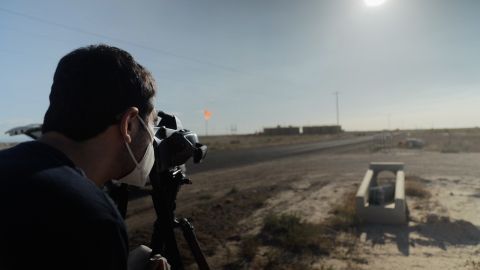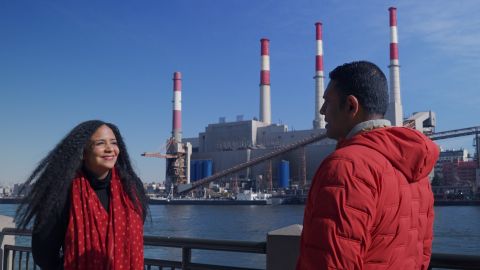An Effort to Protect California’s Frontline Communities from Environmental Health Risks
More than seven million Californians live within a mile of an oil or gas well, which studies show can create silent health hazards. Now, there are efforts to put more distance between people and pollutants. NewsHour Weekend Special Correspondent Tom Casciato has the story, beginning in the small city of Arvin. This story is part of our ongoing series, Peril and Promise: The Challenge of Climate Change.
Read the Full Transcript
Hari Sreenivasan:
Millions of Californians live close to oil and gas drilling and production. It’s a situation that studies show can create a silent health hazard.
Now there are efforts to put more distance between people and drilling operations. NewsHour Weekend Special Correspondent Tom Casciato has the story—beginning in the small city of Arvin, about 100 miles north of Los Angeles.
This story is part of our ongoing series, Peril and Promise: The Challenge of Climate Change.
Tom Casciato:
Arvin is the kind of town where you can drive past an oil pumping operation, keep going for a bit and round the corner to see that it’s next door to a residential street, like Nelson Court. But it was what lurked beneath Nelson Court that led to a local disaster in 2014.
News Anchor:
And we have breaking news out of Arvin tonight where several homes have been evacuated due to a potentially dangerous gas leak.
Tom Casciato:
It began as a small-town story.
News Anchor:
And here’s a look at the affected areas tonight, eight Arvin homes near Nelson Court and Varsity Road are under mandatory evacuations.
Francisco Gonzalez:
The person across from me called the gas company because her husband smelled a lot of gas.
Tom Casciato:
Resident Francisco Gonzalez.
Francisco Gonzalez:
And the person on the other corner’s daughter said that she had fainted.
Tom Casciato:
The smell was from a leaking underground pipe that filled eight homes with highly explosive levels of gas.
News Anchor:
… remaining under evacuation orders due to a dangerous gas leak.
Tom Casciato:
Evacuated residents didn’t return for months.
Cesar Aguirre:
This is a pipe that was built underground before the homes were here.
Tom Casciato:
Cesar Aguirre is a community organizer with the nonprofit group Central California Environmental Justice Network. It works to improve the environment for low income and communities of color.
Cesar Aguirre:
Here we’re born in that caused the climate crisis that we find ourselves in.
Tom Casciato:
He said the oil and gas industry is a common next door neighbor here, and took me on a tour of examples right near where people work, play, and even worship.
Cesar Aguirre:
Right here we’re standing in front of the biggest church in Arvin. As a matter of fact, every December 12th, thousands of people meet in the parking lot and they have a congregation here to celebrate the Virgin Mary. And just on the other side of it there’s oil drilling happening.
Tom Casciato:
There’s a pumping operation right behind the church, featuring what appears to be a ruptured tube, beneath it a black stain.
Cesar Aguirre:
There should be zero oil touching the ground because then it becomes a threat to the groundwater and to the soil.
Tom Casciato:
We reached out for comment to the owner of the well, Sequoia Explorations inc., which acquired it earlier this year. Its CEO, Mark Jacobs, replied, “We have notified our field personnel of this matter and will make sure this is dealt with immediately.” What we saw may not have been catastrophic, but illustrates one feature of living cheek to jowl with a polluting industry. And that’s not just an Arvin thing. According to the nonprofit FracTracker alliance, More than seven million Californians live within a mile of an oil or gas well. Some four million of them are people of color. That means the climate challenge is about a lot more than lowering emissions, says Professor Manuel Pastor.
Manuel Pastor:
What I like to say is that climate change is real, but so is the climate gap. We know from the social science research who is suffering the brunt and likely to suffer the future brunt of that climate change. So much as we need to be lifting up the need to address greenhouse gas emissions and reduce them below the 1990 levels, we need to understand that the terrain of environmental disparities exists and we need to be moving the needle on that as well.
Manuel Pastor:
…And build the ecosystem that can actually support change.
Tom Casciato:
Pastor is a professor of Sociology, American Studies and Ethnicity at the University of Southern California’s Equity Research Institute. He recently co-authored a report addressing – quote – “the central challenges of our time: a heating planet, an unequal economy and persistent racial injustice.” One of its conclusions:
Manuel Pastor:
If you really want to protect communities against environmental hazards, yes, you need rules. Yes, you need laws. But you need community organizing.
Tom Casciato:
The report cites Arvin as a case study in organizing. After the 2014 gas incident, citizens sought to pass an ordinance to keep industry operations at a distance. The president of the Committee For A Better Arvin is Estela Escoto.
Estela Escoto:
We began to work in concert with other community groups, going to see our representatives asking them to pass an ordinance, and going house to house knocking on doors to convince people that we needed an ordinance. At the council meetings they made fun of us, and said we were not going to be able to do anything, or pass an ordinance.
Tom Casciato:
It took four years, with community groups working to elect some new city council members, plus a 23 year old mayor, but the town finally passed an ordinance to keep new drilling operations at least 300 feet from homes and schools, businesses and hospitals. U.C. Berkeley Epidemiologist David Gonzalez believes in the power of community.
David Gonzalez:
My family has roots in the Chicano community in East L.A., so that’s something that I carry with me in my work. These communities have knowledge and know what’s going on. My grandpa didn’t have the chance to go to college, but he’s one of the most brilliant men I ever knew.
Tom Casciato:
But he has concerns about the scope of the Arvin setback.
Tom Casciato:
Does 300 feet strike you as significant as — or as enough?
David Gonzalez:
We’re seeing that oil and gas drilling is affecting the health of people that live within three thousand feet of oil and gas wells and some studies show further away.
Tom Casciato:
Gonzalez and colleagues published a 2020 study showing “evidence that exposure to oil and gas well sites is associated with increased risk of spontaneous preterm birth.”
David Gonzalez:
And having a preterm birth increases risk of infant mortality and being sick and can have long term effects for the infant’s health. And so we want to prevent preterm births.
Tom Casciato:
Gonzalez’ study followed on the heels of a study tying pregnant women’s proximity to oil and gas operations to low birth weights, and a new one detailing “adverse birth outcomes” for Californians living near fracking sites. Other studies have tied proximity to such operations to asthma and other health problems. The Los Angeles region is rife with drilling, though you can’t always tell from road level. Drivers on La Cienega Boulevard can’t see the adjacent Inglewood Oil Field — though a drone can.
In more well-off areas, the operations are disguised as — well it’s not exactly clear what. But they’re pumping oil here in the city’s Mid-Wilshire neighborhood, and here less than two miles down the road. In other parts of town, the less affluent areas, like here in Wilmington in the Southeast, the industry is a more obvious neighbor, sometimes impossible to miss. Activists have long been organizing around here, too.
Ashley Hernandez:
Folks in this community are exposed to chemicals like benzene, volatile organic compounds.
Tom Casciato:
Ashley Hernandez was raised in Wilmington, now she’s a youth organizer with the nonprofit Communities For A Better Environment.
Ashley Hernandez:
That creates a lot of asthma causing issues. And so it’s really a huge part of the communities like DNA to deal with folks that have respiratory issues, to have children that have inhalers. And so it’s definitely a part of growing up here.
Tom Casciato:
Hernandez and others like her may eventually get what they desire. In September, county supervisors voted to ban new oil wells, and reevaluate the ones already there. And last month, Governor Gavin Newsom’s administration proposed a 3200 foot buffer zone between new drilling and homes, hospitals and schools.
In a statement, the nonprofit industry group Western States Petroleum Association said it doesn’t oppose setbacks based on “science, data and rigorous health assessments.” But it claimed the state’s approach would “eliminate tax revenue and community benefits, raise costs for everyone and put thousands of people out of work.”
Meanwhile, in Kern County, where Arvin is, more new drilling is planned, though a judge has halted new permits pending an environmental assessment.
David Gonzalez:
There’s more studies that we can do and that we are doing. I think we have enough evidence to start making policies to protect communities.
Tom Casciato:
And Manuel Pastor says that with one success to their name, organizers aren’t finished fighting to keep the industry at bay.
Manuel Pastor:
You know, the setback ordinance in Arvin is an important first step to protecting communities, but I think it needs to be seen in a broader context. This is a community that stood up to one of the most important industries in its county, 70 percent of oil drilling. Oil extraction in the state of California takes place in Kern County. And the fact that they were able to stand up to economic interests and get that setback ordinance. You know, it’s a small thing, but it’s a big thing symbolically and politically by saying who gets a chance to decide about people’s health versus economic growth.



